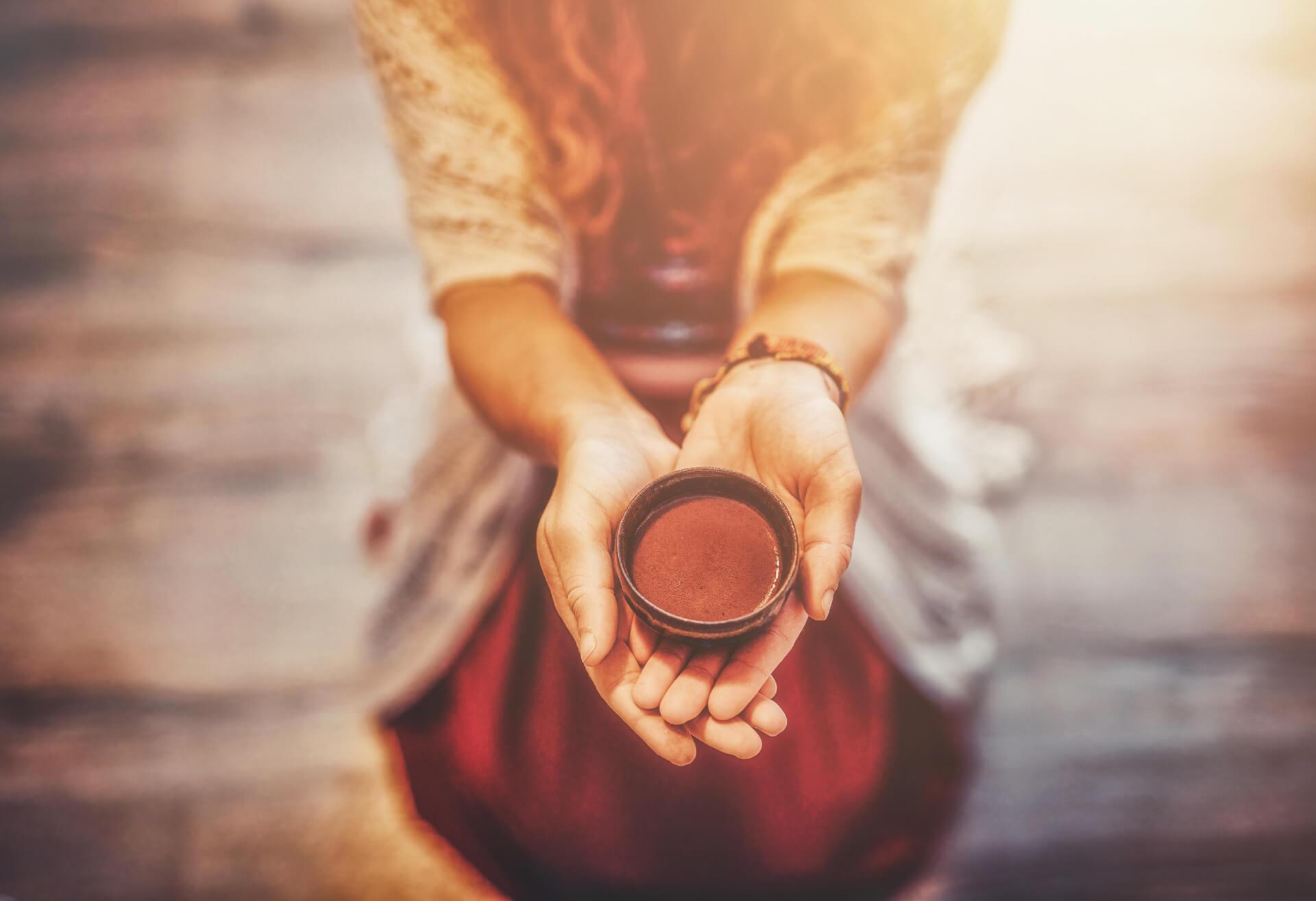A cacao ceremony is a spiritual practice rooted in ancient traditions that uses cacao as sacred medicine. During the ceremony, participants drink a specially prepared cacao beverage to open their hearts and deepen their connection to themselves and others. The ritual is designed to foster a sense of gratitude, intention, and mindfulness, creating a space for personal reflection and emotional healing.
The practice of cacao ceremonies has evolved, blending ancient customs with modern spirituality. By participating in these ceremonies, people often experience a heightened sense of love and openness, thanks to the theobromine in cacao that increases blood flow and creates a “heart-opening” effect. This allows individuals to feel more connected and present in the moment.
Cacao ceremonies often occur in a sacred space where participants set intentions, share insights, and engage in meditative practices. These gatherings can be held solo or in groups and are usually guided by a facilitator who helps create an environment of safety and respect. Each ceremony is unique, as it adapts to the needs and energies of those involved.
Related: Review of Ceremonial Grade Cacao
The Significance of Cacao Ceremonies
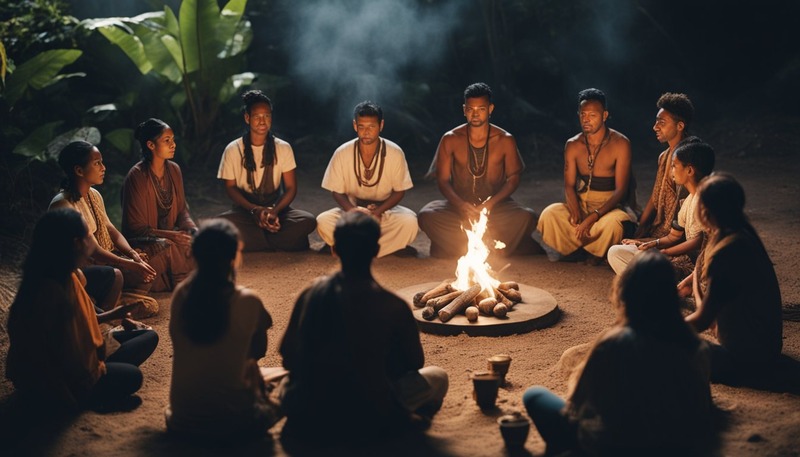
Cacao ceremonies are meaningful experiences rooted in ancient cultures and filled with purpose. They incorporate sacred rituals and intend to connect deeply emotionally and spiritually. Understanding these elements can provide more insight into the rich tradition of cacao ceremonies.
Historical Context
Historically, cacao has been a highly valued commodity for its spiritual and economic significance. Ancient cultures such as the Mayans and Aztecs regarded cacao as sacred. They believed it was a gift from the gods and used it in rituals to honor their deities. The Aztecs even utilized cacao beans as currency, showcasing their immense worth.
Cacao ceremonies today still reflect these ancient practices but have evolved. Modern ceremonies continue to emphasize indigenous traditions’ deep cultural connections and communal aspects. By participating in a cacao ceremony, contemporary individuals can connect with these historical practices, bringing a sense of continuity and respect for ancient wisdom to the experience.
Understanding Intention
At the core of a cacao ceremony is setting and focusing on intention. Participants often enter the ritual with a clear purpose: emotional healing, spiritual growth, or fostering communal bonds. This intention-setting is crucial as it guides the entire experience.
Setting an intention helps individuals focus their minds and energies, making the experience more personal and profound. By clearly defining their purpose, participants can align their thoughts and actions with their desired outcomes, creating a powerful and meaningful experience. This focus on intention is what differentiates a cacao ceremony from simply drinking cacao.
The Role of Cacao
The key element in these ceremonies is ceremonial cacao, which is different from everyday chocolate. Made from cacao beans of the Theobroma cacao tree, this ceremonial cacao retains its natural properties due to minimal processing. This ensures the presence of beneficial compounds like theobromine, which enhances blood flow and leads to a heart-opening sensation.
The consumption of ceremonial cacao serves not just a physical purpose but also a symbolic one. The heart-opening effect of theobromine fosters a sense of connection and love among participants. This unique role of cacao elevates the ceremony, creating an environment where it is easier to explore and express deeper emotions. Cacao becomes both a facilitator and a symbol of the journey participants embark on during the ritual.
Preparation and Participation
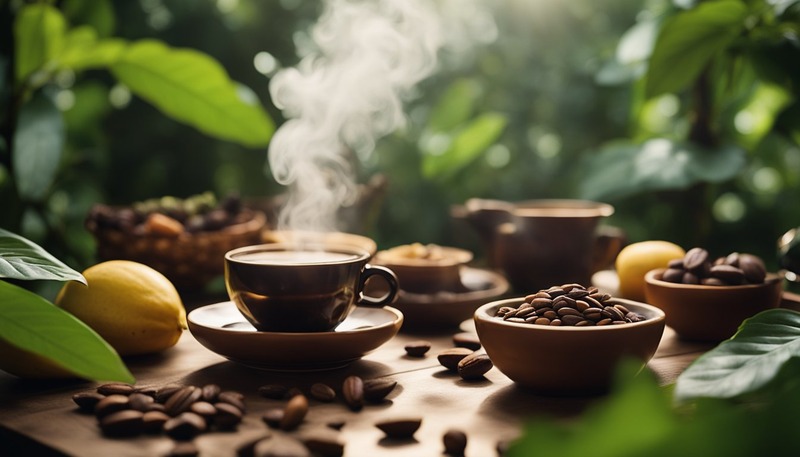
Preparation for a cacao ceremony calls for thoughtful steps to create a meaningful experience. Participants often aim to establish a sacred space, gather essential ceremony elements, and foster community by joining a circle.
Creating a Sacred Space
To prepare for a cacao ceremony, it is vital to create a sacred space. This can be done by choosing a quiet and comfortable area where participants feel safe and relaxed. Cleansing the space with a blessing herb such as sage or palo santo can help to purify and set the tone for the ceremony.
Setting up an altar with significant items like crystals, candles, or personal mementos can enhance the sacredness of the space. The goal is to foster an atmosphere that encourages openness and connection.
Ceremony Elements
Essential elements for a cacao ceremony include high-quality, ceremonial-grade cacao, which is preferred for its purity and potency. Prepared by chopping the cacao into small pieces and gently heating it, some may add spices like cinnamon or cayenne and natural sweeteners like honey to enhance the taste and effects.
Other elements may involve music, meditation, and setting intentions. Music and dance can help participants to engage their senses and elevate their emotional state. Meditating on a specific intention is common before the ceremony begins to align the mind and spirit.
Joining a Circle
Joining a circle for a cacao ceremony enhances the sense of community and shared experience. Circles usually begin with each participant stating their intention or expressing gratitude.
This practice helps to build a collective energy and opens the heart to a more profound connection with others. Throughout the ceremony, participants may share reflections, offer support, or engage in group activities like chanting or guided visualization.
The collective presence within the circle can amplify cacao’s heart-opening qualities, fostering a deeper sense of togetherness and understanding.
The Spiritual and Emotional Journey
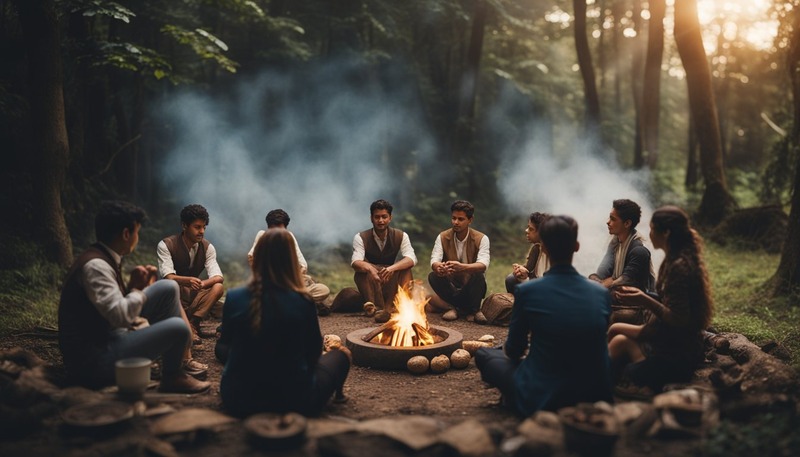
A cacao ceremony allows participants to embark on a deep, introspective journey. This experience can lead to personal healing, increased mindfulness, and a stronger connection with others.
Healing and Transformation
Cacao ceremonies can be transformative. Participants often experience emotional release, allowing them to confront and process feelings they may have suppressed. This healing process can be cathartic, helping individuals to release negative emotions and embrace positivity.
The transformative power of cacao can inspire self-reflection and personal growth. The ceremony creates a sacred space where people can explore their inner selves, fostering emotional and spiritual healing. By facing their vulnerabilities, participants can achieve a sense of renewal and profound transformation.
Meditation and Mindfulness
Meditation and mindfulness are integral parts of a cacao ceremony. Participants often engage in guided meditation, including breathwork and reflective practices. These meditative activities help individuals to quiet their minds and focus on their inner experiences.
Through mindfulness, participants become more aware of their thoughts and emotions. This heightened awareness helps them to live in the moment and appreciate the present. The clarity gained from this practice can be deeply calming, enhancing feelings of peace and contentment.
Fostering Connection and Love
A cacao ceremony can promote feelings of love and connection. The properties of cacao, particularly theobromine, can increase blood flow and create a sensation of the heart opening. This physical response can make people feel more open, loving, and empathetic.
The ceremony often encourages participants to share their experiences and emotions, fostering deep connections with others. By being vulnerable and truthful, individuals can build stronger relationships. This collective journey helps participants to feel a sense of belonging and mutual support.
Physical and Nutritional Benefits
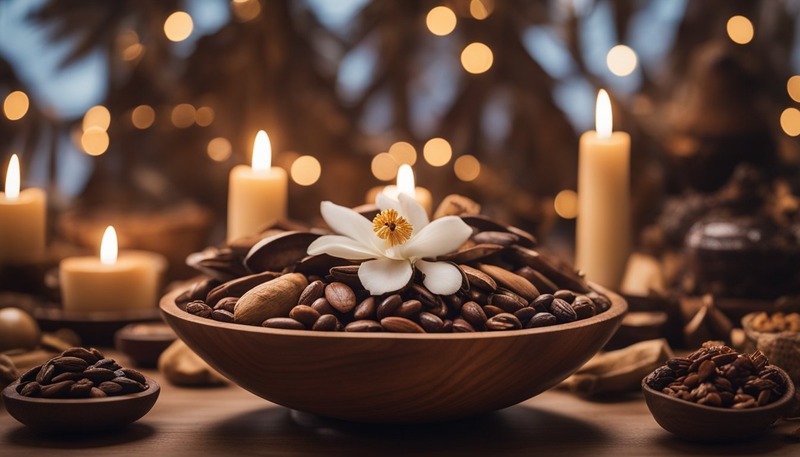
Cacao ceremonies offer various health benefits, primarily due to the rich nutrients found in ceremonial-grade cacao. These nutrients have notable effects on both physical well-being and mood enhancement.
Understanding Cacao’s Nutrients
Ceremonial-grade cacao is packed with essential nutrients. It is a natural superfood containing significant iron, magnesium, and calcium levels. Iron supports blood oxygenation, while magnesium aids muscle function and reduces fatigue. Calcium is crucial for bone health.
This type of cacao also has powerful antioxidants. These antioxidants help reduce inflammation and protect the body from free radical damage. The presence of theobromine enhances blood flow, stimulating mental clarity and physical vitality without the jittery effects of caffeine.
Effects on Health and Well-being
Consuming ceremonial cacao can improve physical health by boosting heart health. The improved blood flow from theobromine supports cardiovascular function. Cacao’s magnesium relaxes muscles and supports neuron functioning, promoting a sense of calm and well-being.
Cacao also affects mood positively. It contains compounds that increase serotonin uptake, resulting in mood-boosting effects that help reduce stress and anxiety. Additionally, the presence of anandamide in cacao, often called the “bliss molecule,” can elevate mood and promote feelings of happiness.
Cacao vs. Traditional Chocolate
There is a distinct difference between ceremonial-grade cacao and traditional chocolate. Ceremonial-grade cacao retains more nutrients because it undergoes minimal processing. This ensures it keeps its natural health benefits intact, unlike most commercial chocolate, which often has added sugars and fats.
Traditional chocolate usually lacks the substantial antioxidants and nutrients found in ceremonial cacao. The added sugars in regular chocolate can also negate some positive health effects by contributing to weight gain and other health issues. In contrast, ceremonial cacao provides a pure and potent form of nutrition that benefits overall health.
Related: Cacao vs Cocoa
Integration and Continued Practice
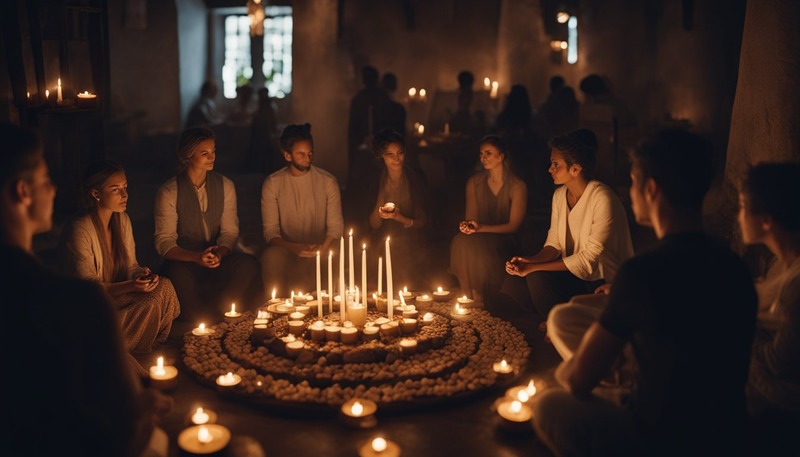
After a cacao ceremony, it’s crucial to integrate the lessons learned and maintain a reflective approach to continue elevating consciousness and deepening spiritual insights.
Incorporating Lessons Learned
Participants often gain profound wisdom and clarity during a cacao ceremony. To incorporate these insights into everyday life, keeping a journal where reflections, thoughts, and inspirations are recorded is helpful. Writing regularly can lead to greater self-reflection and awareness.
Engaging in yoga or chanting can also support these practices by helping to center the mind and open the heart. These activities can turn insights gained from the ceremony into practical actions.
Maintaining a Reflective Approach
A reflective approach involves ongoing self-examination and introspection. Setting aside regular time for meditation or quiet contemplation can encourage this.
Doing so can extend the heart-opening experiences of the ceremony, leading to a more authentic connection with oneself.
Regular reflection on personal growth and spirituality can foster deeper awareness and continued inspiration. Engaging in these practices helps maintain the elevated consciousness achieved during the ceremony.
Expanding Your Spiritual Practices
Beyond reflection, incorporating new spiritual practices can enhance the benefits of a cacao ceremony.
Practices such as group meditations, participation in spiritual retreats, or exploring different forms of spiritual expression can further deepen one’s journey.
Experimenting with different traditions, like incorporating elements of indigenous rituals, can provide a broader understanding and new perspectives.
Continuously expanding spiritual practices ensures that the lessons and energy from the cacao ceremony are woven into a sustainable, ongoing spiritual practice.
Ceremonial Tools and Enhancements
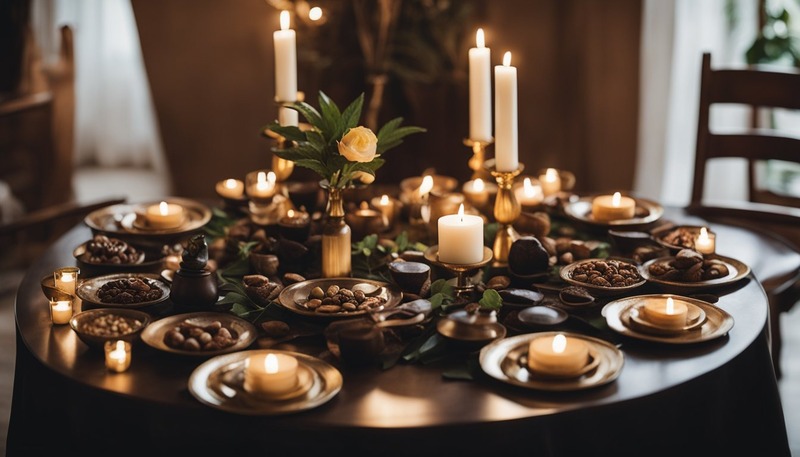
To create a meaningful cacao ceremony, attentiveness to selecting the right cacao, setting the stage with music and chanting, and engaging in creative exercises is paramount. Each element enhances the experience’s depth and personal resonance.
Selecting Quality Ceremonial Cacao
It is crucial to choose real, ceremonial-grade cacao. This type of cacao is 100% pure cacao bean paste and is known for its higher quality and potency.
It is specifically prepared to maintain its natural properties, ensuring it facilitates a deep, heart-opening experience. Participants often choose cacao from reputable sources to ensure its purity and origins.
The preparation involves chopping the cacao into small pieces and gently heating it, sometimes with spices or sweeteners, to create a rich, smooth beverage.
Creating an Atmosphere with Music and Chanting
Music and chanting play a significant role in setting the atmosphere for a cacao ceremony.
Soft, rhythmic music helps participants relax and open their hearts. Traditional instruments like drums or flutes can create a sacred ambiance.
In group settings, chanting often enhances the collective energy and spiritual connection.
Choosing specific chants that resonate with the participants is common, further deepening the ceremonial experience and fostering unity.
Engaging in Creative Exercises
Creative expression is a powerful aspect of cacao ceremonies. Participants might engage in various exercises, such as drawing, journaling, or dancing.
These activities help channel the cacao’s energy into personal insights and emotional release. Creativity allows individuals to connect with their inner selves, often revealing hidden feelings or thoughts.
The choice of exercises depends on the group’s dynamics and the ceremony’s intended outcome. Creative engagement ensures that the ceremony is a spiritual journey and a personal and expressive experience.
The Global Cacao Movement
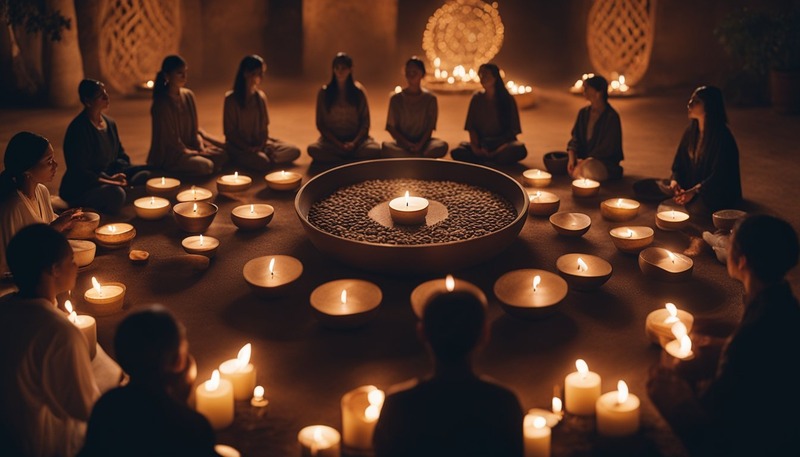
The global movement of cacao ceremonies is touching many aspects of modern life. From promoting spiritual practices to boosting local economies, these ceremonies are becoming a significant cultural and economic force.
Expansion of Cacao Ceremonies Worldwide
Cacao ceremonies have spread far beyond their indigenous origins. Once primarily found in Central and South America, they are now popular worldwide.
In the early 2000s, an American who moved to Guatemala helped revive these ceremonies, blending traditional practices with contemporary spiritual approaches.
The wide appeal lies in their ability to foster a deep connection with the earth and one’s inner self.
Contribution to Local Economies
The rise of cacao ceremonies has also boosted local economies, especially in regions where the cacao bean is harvested.
Countries like Mexico, Guatemala, and Ecuador have seen increased demand for high-quality, ceremonial-grade cacao.
This demand supports local farmers and small businesses. By purchasing directly from these communities, the profits help sustain local agriculture and eco-friendly farming practices.
The ceremonial cacao market provides a steady income, promoting sustainable development and preserving cultural traditions.
Building a Community of Practitioners
Cacao ceremonies are not just about consuming cacao; they are about building a global community.
These gatherings often include guided meditations, journaling, and sometimes even movement practices like dance or yoga.
Participants form a circle, sharing their experiences and insights, which fosters a sense of belonging and connection.
This communal aspect aligns with the ceremonies’ spiritual goals, seeking to open the heart and enhance attendees’ feelings of unity and empathy. The sharing circle at the end of each ceremony is a core part of this community-building process.
Frequently Asked Questions
Cacao ceremonies offer many benefits and have a rich history rooted in indigenous traditions. Here, we answer common questions related to cacao ceremonies’ practice, preparation, and effects.
1. What are the benefits of attending a cacao ceremony?
Cacao ceremonies provide several benefits, including improved heart health due to increased blood flow and antioxidants like flavonoids that reduce inflammation. Read more about cacao’s health benefits here.
Participants also report elevated moods because cacao contains serotonin precursors, which contribute to feelings of happiness and well-being.
2. How does one prepare for a cacao ceremony at home?
To prepare for a cacao ceremony at home, choose ceremonial-grade cacao. Avoid adding sugar, dairy, or fats.
Create a quiet, comfortable space for meditation. Set intentions for the ceremony and be in a relaxed state of mind.
Follow the ritual respectfully to connect deeply with yourself and the experience.
3. Who is advised against participating in a cacao ceremony?
People with heart conditions or those on certain medications should avoid cacao ceremonies.
Theobromine in cacao can affect heart rate and blood pressure. Pregnant women and those sensitive to caffeine should also consult a healthcare provider before participating.
4. What spiritual effects are associated with cacao in ceremonial practices?
Ceremonial cacao is known for its heart-opening properties, helping participants feel more love and connection with themselves and others.
It also facilitates deep meditation and spiritual insights. The theobromine in cacao increases blood flow and enhances awareness, aiding in spiritual and emotional healing.
5. How is ceremonial grade cacao different from regular cacao?
Ceremonial-grade cacao is made from heirloom strains native to Central and South America. It contains between 90 and 99% cacao by weight and is processed with minimal roasting.
This type of cacao is free from added sugars, dairy, or fats, ensuring its purity and potency compared to regular cacao.
6. Can you explain the historical significance of cacao ceremonies?
Cacao ceremonies have a long history in indigenous cultures of Central and South America.
These rituals are sacred practices using cacao to connect individuals with the divine and facilitate inner healing.
Cacao has been revered as a holy plant, essential for its heart-opening and mystical properties.
7. Is ceremonial cacao legal?
Yes, ceremonial cacao is legal. Cacao does not contain psychoactive substances that are restricted or illegal, unlike some ceremonial plants. It can be freely used for rituals and ceremonies without legal concerns.

